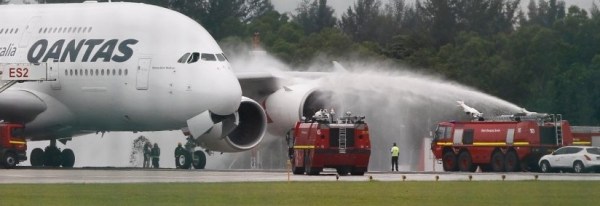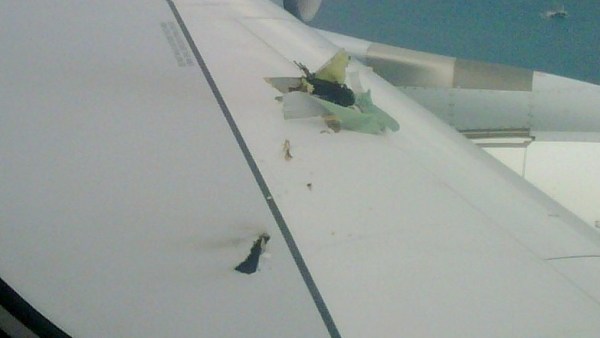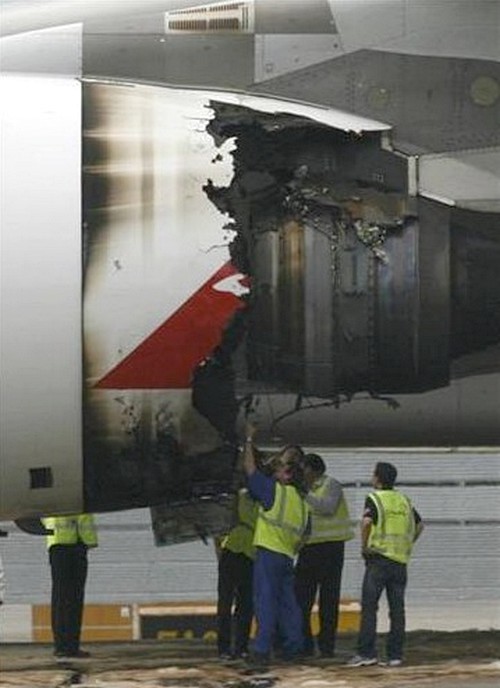
The seriousness of the Qantas A380 incident at Singapore and over Batam Island earlier today is made apparent by photos of the damage placed on the public domain by some of the passengers.

They show that what has been identified as a part of a turbine blade passed through the wing above the No 2 engine (shown above) and lodged a short distance behind the leading edge but in front of a major fuel tank, where there is indirect evidence that it severed some of the wiring that relays instructions to the outermost No 1 engine.
That evidence is seen in images of the fire tenders being used to douse the No 1 engine (top of page) after the giant jet came to a standstill, as it could not otherwise be shut down while fuel remained accessible to it.
The photos also show that at least part of the hydraulic functions of the A380 had been rendered inoperative, with visual clues that the nose wheel may have relied on a gravity drop rather than hydraulics to power it into the locked down position, and that the slats on the wing had not been deployed before landing resulting in a faster and longer landing roll.

The sources spoken to differed on whether small fragments of the disintegrated No 2 engine that punctured the wing further aft (detail above), in the area containing fuel tanks, were really responsible for reports of fuel leaking from the back of the wing as the jet finally landed back at Changi almost two hours after the incident began with that engine failing explosively about six minutes after takeoff for Sydney.
The cautious assessments given to Plane Talking refer to details that can only be resolved by the accident investigation despite the clues in the passenger and news report images.
But the problems that beset the pilots when the No 2 engine blew help explain two things, the length of time taken to return to Singapore Airport, and the conviction shown by Alan Joyce when he grounded the Qantas A380 fleet.
The pilots clearly took their time dumping and consuming fuel while they assessed the situation and discussed it with Qantas operations and most likely Airbus and Rolls-Royce, dealing as best they could with control issues affecting the No 1 engine, and working with the airport authorities on the plan for shutting it down after touchdown.
There would have been careful consideration of everything else that could have gone wrong in an abnormal landing. Joyce and a response team would learned very quickly how potentially catastrophic the engine failure had been, and arrangements to rebook literally thousands of Qantas A380 travellers for an indefinite period would have begun well before he announced the grounding of the giant jets.
One of certification standards for passenger jet engines is the ‘containment’ of component failures. This was a severe uncontained failure by the Rolls-Royce engine. The cause must be found and corrected, whether it is a flaw in a component, an error in assembly or overhaul, or a hitherto undetected design failing.
Whatever it was, it has to be found and fixed. Joyce had no choice in the actions he took.

The other users of the Rolls-Royce Trent 900 on A380s are Singapore Airlines and Lufthansa. The German flag carrier has only recently started its A380 operations, while Singapore Airlines has 11 A380s in service, compared to six with Qantas, and has been flying the type longer.
However the history of engine issues in airliners in general is not linear. Long established designs have sometimes exhibited faults in recent builds because of production or materials imperfections. Or maintenance issues. There is no reason to assume that anything that happens in service to Qantas will happen to another airline, or vice versa.
Qantas, the ATSB, its Singaporean and Indonesian counterparts, and Rolls-Royce, all have a serious puzzle to solve.







Crikey is committed to hosting lively discussions. Help us keep the conversation useful, interesting and welcoming. We aim to publish comments quickly in the interest of promoting robust conversation, but we’re a small team and we deploy filters to protect against legal risk. Occasionally your comment may be held up while we review, but we’re working as fast as we can to keep the conversation rolling.
The Crikey comment section is members-only content. Please subscribe to leave a comment.
The Crikey comment section is members-only content. Please login to leave a comment.